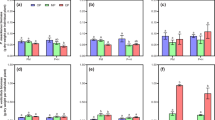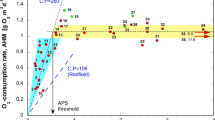Abstract
Planktonic nutrient regeneration is a fundamental process that maintains most of the primary productivity in marine and freshwater environments. However, there is no robust predictive model to describe the pattern and efficiency of nutrient cycling across aquatic systems. Based on rather weak evidence, the efficiency of nutrient regeneration is believed to decline along a gradient of productivity, so that nutrient-poor environments are assumed to be more efficient at cycling their nutrients than are nutrient-rich environments1,2,3,4,5. Here we measure phosphorus regeneration directly and show that cycling efficiency does not vary with phosphorus concentration. In addition, we confirm that the phosphorus supply for lake plankton comes primarily from within the plankton community, rather than from external loading or from larger organisms such as fish.
This is a preview of subscription content, access via your institution
Access options
Subscribe to this journal
Receive 51 print issues and online access
$199.00 per year
only $3.90 per issue
Buy this article
- Purchase on Springer Link
- Instant access to full article PDF
Prices may be subject to local taxes which are calculated during checkout


Similar content being viewed by others
References
Goldman, J. C. in Flows of Energy and Materials in Marine Ecosystems 1st edn, vol. 13(ed. Fasham, M.J.R.) 137–170 (Plenum, New York, 1984).
Sheldon, R. W. Phytoplankton growth rates in the tropical ocean. Limnol. Oceanogr. 29, 1342–1346 (1984).
Capblancq, J. Nutrient dynamics and pelagic food web interactions in oligotrophic and eutrophic environments: an overview. Hydrobiologia 207, 1–14 (1990).
Harris, G. P. Phytoplankton Ecology: Structure, Function and Fluctuation 1st edn (Chapman and Hall, London, 1986).
Harris, G. P. Pattern, process and prediction in aquatic ecology. A limnological view of some general ecological problems. Freshwat. Biol. 32, 143–160 (1994).
Wetzel, R. G. Limnology 2nd edn (Saunders, New York, 1983).
Hudson, J. J. & Taylor, W. D. Measuring regeneration of dissolved phosphorus in planktonic communities. Limnol. Oceanogr. 41, 1560–1565 (1996).
8.An Ecosystem Approach to Aquatic Ecology: Mirror Lake and its Environment 1st edn (ed. Likens, G. E.) (Springer, New York, 1985).
Caraco, N. F., Cole, J. J. & Likens, G. E. New and recycled primary production in an oligotrophic lake: insights for summer phosphorus dynamics. Limnol. Oceanogr. 37, 590–602 (1992).
Kraft, C. E. Phosphorus regeneration by Lake Michigan alewives in the mid-1970s. Trans. Am. Fish. Soc. 122, 749–755 (1993).
Perezfuentetaja, A., McQueen, D. J. & Ramcharan, C. W. Predator-induced bottom-up effects in oligotrophic systems. Hydrobiologia 317, 163–176 (1996).
Vanni, M. J. in Food Webs: Integration of Patterns and Dynamics 1st edn (eds Polis, G. A. & Winnemiller, K. O.) 81–95 (Chapman and Hall, New York, 1996).
Schaus, M. H.et al. Nitrogen and phosphorus excretion by detritivorous gizzard shad in a reservoir ecosystem. Limnol. Oceanogr. 42, 1386–1397 (1997).
Horppila, J.et al. Top-down or bottom-up effects by fish: issues of concern in biomanipulation of lakes. Restoration Ecol. 6, 20–28 (1998).
Nakashima, B. S. & Leggett, W. C. The role of fish in the regulation of phosphorus availability in lakes. Can. J. Fish. Aquat. Sci. 37, 1540–1549 (1980).
den Oude, P. J. & Gulati, R. D. Phosphorus and nitrogen excretion rates of zooplankton from the eutrophic Loosdrecht lakes, with notes on other P sources for phytoplankton requirements. Hydrobiologia 169, 379–390 (1988).
Mazumder, A.et al. Partitioning and fluxes of phosphorus: mechanisms regulating the size-distribution and biomass of plankton. Arch. Hydrobiol. Beih. 35, 121–143 (1992).
Cyr, H. & Pace, M. L. Magnitude and patterns of herbivory in aquatic and terrestrial ecosystems. Nature 361, 148–150 (1993).
Baines, S. B. & Pace, M. L. Relationship between suspended particulate matter and sinking flux along a trophic gradient and implications for the fate of planktonic primary production. Can. J. Fish. Aquat. Sci. 51, 25–36 (1994).
Schindler, D. W. Evolution of phosphorus limitation in lakes. Science 195, 260–262 (1977).
Edmondson, W. T. The Uses of Ecology: Lake Washington and Beyond 1st edn (Univ. Washington Press, Seattle, 1991).
Parsons, T. R., Maita, Y. & Lalli, C. M. A Manual of Chemical and Biological Methods for Seawater Analysis 1st edn (Pergamon, Oxford, 1984).
23.Atlas of Alberta Lakes 1st edn (eds Mitchell, P. & Prepas, E.) (Univ. of Alberta Press, Edmonton, 1990).
Lin, C. K. Phytoplankton Succession in Astotin Lake, Elk Island National Park, Alberta (Thesis, Univ. Alberta, Edmonton, 1968).
Gingras, B. A. & Paszkowski, C. A. Breeding patterns of common loons on lakes with three different fish assemblages in north-central Alberta. Can. J. Zool.(in the press).
26.Prince Albert National Park Resource Description and Analysis vol. 2(Canadian Park Service) (Environment Canada, Parks, Prairie and Northern Region, Winnipeg, Manitoba, 1986).
Anderson, S. R. Crustacean plankton communities of 340 lakes and ponds in and near the national parks of the Canadian Rocky Mountains. J. Fish. Res. Board. Can. 31, 855–869 (1974).
Ramcharan, C. W.et al. Acomparative approach to determining the role of fish predation in structuring limnetic ecosystems. Archiv. Hydrobiol. 133, 389–416 (1995).
Acknowledgements
We thank T. Paul, J. Almond, S. Leung, T. MacDonald, L. Lawton, B. Rolseth and B.Parker for field and laboratory assistance; D. McQueen and the Dorset Research Centre for logistical support at Mouse and Ranger Lakes; D. Watters, D. Donald, C. Paszkowski, B. Gingras, P. Mitchell and D.Zell for help with lake selection; and M. Pace, J. Murie and G. M. Taylor for helpful criticisms of the manuscript. This work was supported by a scholarship (NSERC, Canada) and a Killam postdoctoral fellowship (University of Alberta) to J.J.H., and NSERC operating grants to W.D.T. and D.W.S.
Author information
Authors and Affiliations
Corresponding author
Rights and permissions
About this article
Cite this article
Hudson, J., Taylor, W. & Schindler, D. Planktonic nutrient regeneration and cycling efficiency in temperate lakes. Nature 400, 659–661 (1999). https://doi.org/10.1038/23240
Received:
Accepted:
Issue Date:
DOI: https://doi.org/10.1038/23240
This article is cited by
-
Analysis of spatio-temporal variation in phytoplankton and its relationship with water quality parameters in the South-to-North Water Diversion Project of China
Environmental Monitoring and Assessment (2021)
-
Dynamics of nutrient and phytoplankton in Epe Lagoon, Nigeria: possible causes and consequences of reoccurring cyanobacterial blooms
Applied Water Science (2020)
-
A study of bioavailable phosphorus in the inflowing rivers of Lake Taihu, China
Aquatic Sciences (2020)
-
Field observation and simulation experiments on nutrient transformation during phytoplankton-derived particulate matter deposition
Environmental Science and Pollution Research (2020)
-
Different pathways of nitrogen and phosphorus regeneration mediated by extracellular enzymes in temperate lakes under various trophic state
Environmental Science and Pollution Research (2018)
Comments
By submitting a comment you agree to abide by our Terms and Community Guidelines. If you find something abusive or that does not comply with our terms or guidelines please flag it as inappropriate.



